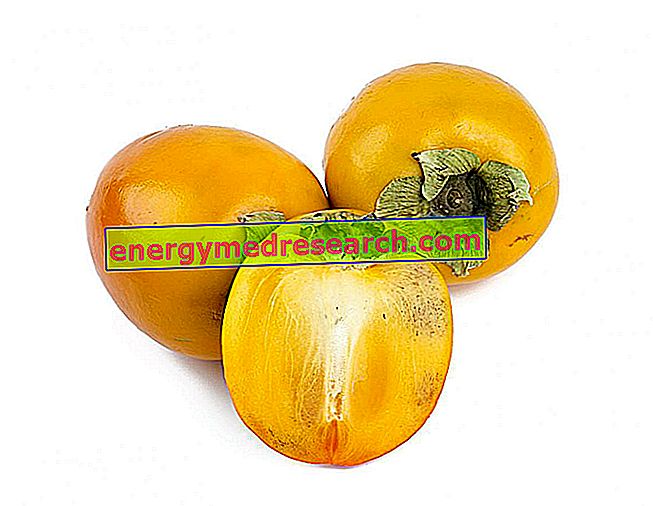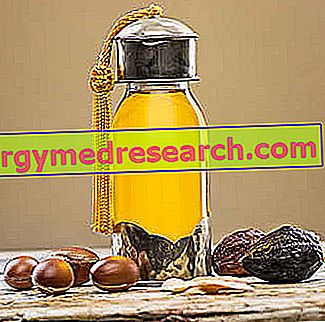Generality
Turmeric and curcumin
Curcumin is a bright yellow-orange vegetable pigment. It is abundantly represented in the tuberized rhizome (root) of various species of turmeric, in particular in that of Curcuma longa (or Curcuma domestica ).

Similar to the shade of saffron, in the food and cosmetic industry curcumin is a yellow-orange coloring food additive, labeled with the abbreviation E100.
In feeding, curcumin is also used as a supplement, due to its nutritional properties.
Curcumin applications
To summarize, the most frequent destinations for curcumin are:
- Dietary supplement or dietary reinforcement
- Food or cosmetic additive
- Flavoring for foods, such as, for example, turmeric-flavored beverages particularly common in Japan.
The annual sales of curcumin have increased especially since 2012, thanks to the increase in popularity as a dietary supplement (food supplement).
Moreover, it is increasingly common in cosmetics for skin care based on "natural ingredients".
As a dye, it is mainly used in the Asian continent.
The most economically significant market is located in North America, where in 2014 sales exceeded 20 million dollars.
Curcumin in food
Curcumin is the most abundant and characteristic curcumid of curcuma (root).
According to some studies, the average curcumin content in the dried powdered turmeric root is around 3%, a value that varies considerably (1.06% - 5.70%) in relation to the species, the soil and the environmental conditions in where the plant grows.
The concentrations of curcumin in curry and other derivative products would be modest and even more variable.
Discovery of curcumin
Curcumin was first isolated from the rhizomes of curcuma in 1815 by Vogel and Pelletier, who gave it the name still in use today.
Curcumin chemistry
Curcumin belongs to the group of curcuminoids.
From the chemical-nutritional point of view, curcumin is classified among the phenols (more precisely polyphenols ) and, as we will describe, it boasts a series of metabolic advantages to say the least significant.
In particular, curcumin is part of a small class of secondary plant metabolites, called "diarylheptanoids".
In its chemical structure, it incorporates various functional groups, whose structure was identified only in 1910 (almost a century after its discovery).
Curcumin is used as an indicator for boron and reacts with boric acid to form a reddish compound called "rosocyanine".

Indications
When to use curcumin?
Despite the mechanism of action of curcumin, and more generally of curcuminoids, has not yet been fully understood, recent evidence has outlined the first therapeutic indications.
More precisely, curcumin and curcuminoids would seem to perform functions:
- Antioxidants: protecting cellular structures from the damaging effects of oxygen free radicals
- Anti-inflammatory: reducing the expression of enzymes involved in the development of the inflammatory reaction
- Antitumorals: on the one hand inhibiting the neoangiogenesis process and on the other inducing the apoptotic process.
For these reasons, curcumin and curcuminoids have been used for many years:
- Treatment of inflammatory pathologies, also chronic
- Prevention of aging and oxidative diseases such as cataract
- Management of arthritic and arthritic pathology
- Prevention of neurodegenerative diseases such as Alzheimer's
- Detoxification from toxic substances
- Hepato-protection.
Property and Effectiveness
What benefit has curcumin shown during the studies?
The most interesting properties of curcumin - because potentially useful in the treatment of a rather wide range of pathologies - are those:
- Antioxidants
- Anti inflammatory
- Anticancer.
Very interesting studies are currently published in the literature on the potential preventive and therapeutic effects of curcumin and curcuminoids.
Although much of this work has been carried out on experimental models, precious indications are not lacking even in vivo for human beings.
However, there is a metabolic aspect which, if on the one hand represents a drawback due to the generic effect of the tumoral forms, on the other hand it attributes to curcumin a specific efficacy on the digestive system; we are talking about bioavailability.
Bioavailability of curcumin
Clinical studies conducted on humans reveal how curcumin is a poorly bioavailable molecule when taken orally; more precisely, curcumin is rapidly conjugated in the liver and in the intestine in curcumin glucuronide and curcumin sulfate, or reduced to hexahydrocurcumine; these metabolites have a lower biological activity than curcumin.
Pharmacokinetic studies have shown that if curcumin is taken at doses lower than 3.6-4 g / day, curcumin itself and its metabolites may not be detectable in plasma.
On the other hand, there is scientific evidence that curcumin administered orally tends to accumulate in the tissues of the digestive tract, where it is not by chance that it performs its most interesting and demonstrated biological and therapeutic activities. Outside of this trait, the limited bioavailability of the substance raises more doubts about the potential clinical applications, very promising in vitro and on animal models, but difficult to transfer to the whole human being. Not by chance, the ability of curcumin to induce the death of various types of tumor cells in vitro, has aroused interest above all in the prevention of some types of cancer, such as oral, gastric, hepatic, pancreatic and especially colon-rectal.
Turmeric and cancer
Along with lycopene (tomatoes), genistein (soy), resveratrol (red wine), quercetin (onions, capers, many other vegetables) and epigallocatechin-3 gallate (green tea), curcumin is one of the most studied plant molecules for potential antioxidant, anti-inflammatory and chemopreventive properties against different types of cancer.
While lycopene and genistein have shown potential applications against prostate cancer, resveratrol and curcumin seem more active against colon cancer.
As we have already explained, curcumin tends to accumulate in the tissues of the digestive tract, for which it finds greater preventive-therapeutic applications.
At the present stage of science, the integration with curcumin can absolutely be taken into consideration by the physician both with a view to preventing the development of gastro-intestinal tumors in predisposed subjects, and as an adjunct to traditional chemotherapists such as 5-fluorouracil and oxaliplatin.
Promotional Content

Anti-age supplement - X115 Primary
New generation anti-aging supplement rich in substances with antioxidant and anti-inflammatory action. Double Day & Night formulation with high concentration of assets; with resveratrol, curcumin, piperine, lipoic acid and echinacea. " More information "
Curcumin and inflammation
There are numerous works, both experimental and clinical, related to the usefulness of curcumin in the management of inflammatory diseases.
Observed the ability to inhibit the expression of inflammatory mediators, such as TNF alpha, IL1 and IL8, the use of curcumin proved to be valuable during inflammatory diseases such as rheumatoid arthritis, Crohn's disease, ulcerative rectocolitis, chronic anterior uveitis and other rare diseases, characterized by chronic inflammation. In addition to modifying the course and intensity of the disease, this integration has led to a marked improvement in the quality of life of affected patients.
Curcumin and Alzheimer
According to some authors, the adequate use of curcumin could cause a reduction in the neuronal accumulation of beta amyloid protein.
This histological change would be followed by a slowing down of the progression of the pathology, with the improvement of some cognitive parameters.
Curcumin and cardiovascular health
Curcumin and curcuminoids would also be effective in reducing cardiovascular risk. The protective action is due to the ability to inhibit the oxidation of LDL lipoproteins - known for their high atherogenicity - and to reduce vascular damage. These results, for the time being observed only in experimental models, could however constitute important applications in the clinical setting.
Curcumin and C-reactive protein
Curcumin appears to reduce the serum levels of C-reactive protein, although no dose-response relationship was observed.
- The excess of C-reactive protein is related to systemic inflammation, which in turn manifests itself in certain chronic diseases.
Curcumin: what does science say today?
According to a 2017 review, which involved over 120 studies, curcumin has not shown any success in any clinical trial considered.
This certainty led the authors to conclude that
"Curcumin is a reactive compound but not bioavailable and unstable; consequently, it is highly unlikely that a significant advantage can be gained in the clinical setting."
Fraudulent studies on curcumin
Studies conducted on the interaction between curcumin and cancer conducted by Bharat Aggarwal, a former researcher at the "MD Anderson Cancer Center", were deemed fraudulent and subsequently withdrawn by the publisher.
Doses and Mode of Use
How to use curcumin and curcuminoids?
In recent years various forms of patented curcumin have arisen, where the substance is worked in such a way and / or conjugated to other molecules in order to favor its absorption.
Given that the half-life after oral administration varies from two to eight hours, it is desirable to take curcumin in multiple doses (3 or 4) during the day.
The usual recommended doses range from 400 to 800 mg, to be repeated three times a day.
It is recommended to take it on a full stomach and with piperine or bromelain to improve absorption.
Side effects
Two preliminary clinical studies carried out in cancer patients who consumed high doses of curcumin (up to 8 grams per day for 3-4 months) showed no toxicity, although some individuals reported nausea or mild diarrhea.
Furthermore, the use of curcumin and curcuminoids, although rarely, has been associated with the appearance of:
- Epigastric pains and gastritis
- Transient hypertransaminasemia.
Contraindications 

When should curcumin not be used?
The use of curcumin and curcuminoids is contraindicated in case of hypersensitivity to the active ingredient, biliary lithiasis and obstructive pathologies of the biliary tract.
Pharmacological Interactions
Which drugs or foods can modify the effect of curcumin and curcuminoids?
There are several documented drug interactions between curcumin or curcuminoids and other active ingredients. Among these, it would be appropriate to remember:
- Interaction with chemotherapeutic agents, responsible for an increase in the antitumor action of these drugs
- Interaction with antiplatelet agents (Plavix, Aspirinetta, CardioAspirin) responsible for an increase in anti-aggregation activity
- Interaction with oral anticoagulants such as Warfarin (Coumadin or Sintrom), potentially responsible for an increased bleeding risk.
In contrast, the contextual intake of Piperina and Bromelaine could increase intestinal absorption, and bioavailability, of curcumin.
In experimental studies, curcumin would also be effective in reducing the nephrotoxicity of some active ingredients.
Precautions for Use
What do you need to know before taking curcumin and curcuminoids?
The use of curcumin should be avoided, given the absence of studies in this regard, during pregnancy and in the subsequent period of breastfeeding.
Careful medical supervision during curcumin intake would instead be necessary in patients suffering from gastroesophageal reflux or peptic ulcer, given the potential irritant action against gastric mucosa. For the same reason, it would be preferable to take curcumin or curcuminoid supplements during the meal.
Although some clinical trials support the therapeutic activity of curcumin in the presence of various diseases, it is good not to get lost in excessive enthusiasm, at least until more and more convincing scientific evidence is available. It is therefore inadvisable to abandon traditional drug therapy without first consulting your doctor.



